|
|
 |
|
Calanoida ( Order ) |
|
|
|
Diaptomoidea ( Superfamily ) |
|
|
|
Centropagidae ( Family ) |
|
|
|
Centropages ( Genus ) |
|
|
| |
Centropages calaninus (Dana, 1849) (F,M) | |
| | | | | | | Syn.: | Cyclopsina calanina Dana,1849;
Hemicalanus calaninus Dana, 1852;
? Centropages tenuicornis Dana, 1849 | | | | Ref.: | | | Giesbrecht, 1892 (p.305, 321, 771, figs.F,M); Giesbrecht & Schmeil, 1898 (p.58, Rem. F,M); Thompson & Scott, 1903 (p.234, 247); Wolfenden, 1905 (1906) (p.1014, figs.F); A. Scott, 1909 (p.113, Rem.); Dakin & Colefax, 1933 (p.205); Farran, 1936 a (p.108); Mori, 1937 (1964) (p.61, figs.F,M); Dakin & Colefax, 1940 (p.92, figs.F); Wilson, 1942 a (p.177, fig.M); Sewell, 1947 (p.163); Chiba, 1956 (p.59, figs.F); Brodsky, 1962 c (p.130, figs.F,M); Grice, 1962 (p.220, figs.F,M); Tanaka, 1963 (p.8, Rem.F,M); Kasturirangan, 1963 (p.33, 35, figs.F,M); Vervoort, 1964 b (p.309); Chen & Zhang, 1965 (p.75, figs.F,M); Saraswathy, 1966 (1967) (p.78); Kos, 1972 (Vol.I, figs.F,M, Rem.); Marques, 1976 (p.993); Greenwood, 1977 (p.61); Björnberg & al., 1981 (p.644, figs.F,M); Zheng & al., 1982 (p.53, figs.F,M); Chihara & Murano, 1997 (p.765, Pl.83,86: F,M); Mulyadi, 1998 (p.58, figs.F,M); Bradford-Grieve & al., 1999 (p.884, 951, figs.F,M); Bradford-Grieve,1999 b (p.136, figs.F,M, Rem., figs.180, 192); Conway & al., 2003 (p.115, figs.F,M, Rem.); Mulyadi, 2004 (p.127, figs.F,M, Rem.); Vives & Shmeleva, 2007 (p.478, figs.F,M, Rem.); Phukham, 2008 (p.67, figs.F,M) |  issued from : Mulyadi in The Raffles Bull. Zool., 1998, 46 (1). [Fig.3,p.59]. Female: a, habitus (dorsal view); b, urosome (ventral view); c, P5. Nota: Prosome 2.5 times as long as urosome. A1 24-segmented, reaching distal end of caudal rami by the last 2 segments. Exopod segment 2 with small notch on outer margin Genital complex somewhat swollen and symmetrical. Urosomal segment 3 more than twice length of urosomal segment 2, with small ventral lamella near distal end. Caudal rami asymmetrical, right ramus longer and thicker than left one. Male: d, habitus (dorsal view); e, P5. Nota: Prosome and urosome asymmetrical.
|
 issued from : Brodsky K.A. in Issled. dal'nevost. Morei SSSR., 1962, 8. [Fig.31, p.130]. Female: a, urosome (ventral view); b, idem (lateral view; c, idem (dorsal view); d, P5. Male: e, posterior part of Th5 and urosome (dorsal view); f, P5 (L: left, R: right).
|
 issued from : Grice G.D. in Fishery Bull. Fish Wildl. Serv. U.S., 61 (186). [Plate 23, 13-18, p.219]. Female: 13, Th5 and urosome (lateral view); 14, P5. Male: 15, habitus (dorsal view); 16, idem (lateral view); 17, P5; 18, exopod of left P5.
|
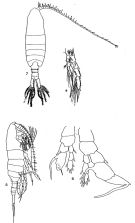 issued from : Mori T. in The pelagic Copepoda from the neighbouring waters of Japan; S. Shirai ed., Tokyo, 1937; 2nd edit., 1964. [Pl.30, figs.4-7]. Female: 4, P5; 7, habitus (dorsal view). Male: 5, habitus (lateral view); 6, P5.
|
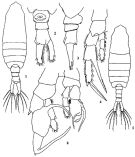 issued from: Q.-c Chen & S.-z. Zhang in Studia Marina Sinica, 1965, 7. [Pl.27, 1-6]. Female (from E China Sea): 1, habitus (dorsal); 2, urosome (ventral); 3, idem (lateral right side); 4, P5 (posterior). Male: 5, habitus (dorsal); 6, P5 (anterior).
|
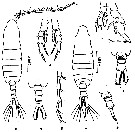 issued from : Z. Zheng, S. Li, S.J. Li & B. Chen in Marine planktonic copepods in Chinese waters. Shanghai Sc. Techn. Press, 1982 [p.54, Fig.30]. Female: a, habitus (dorsal); b-c, urosome (lateral and ventral, respectively); d, P5. Male: e, habitus (dorsal); f, urosome (dorsal); g, grasping segments of right A1; h, P5.
|
 issued from : G.D. Grice in Fish. Bull. Fish and Wildl. Ser., 1962, 61. [p.219, Pl.23, Figs.13-18]. Female (from equatorial Pacific): 13, posterior part of thorax and urosome (lateral, right side); 14, P5. Nota: The anal segment has a small knob on the ventral surface near the posterior end. The spine-like protrusions of the 2nd exopodal segments of P5 exceed the tip of the 3rd exopodal segments. Male: 15-16, habitus (dorsal and lateral, respectively); 17, P5; 18, exopod of left P5. Nota: Long and bent thumb of the chela.
|
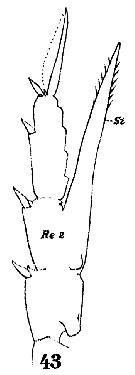 Issued from : W. Giesbrecht in Systematik und Faunistik der Pelagischen Copepoden des Golfes von Neapel und der angrenzenden Meeres-Abschnitte. – Fauna Flora Golf. Neapel, 1892, 19 , Atlas von 54 Tafeln. [Taf.17, Fig.43]. Female: 43, exopod of P5 (posterior view).
|
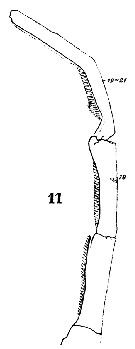 Issued from : W. Giesbrecht in Systematik und Faunistik der Pelagischen Copepoden des Golfes von Neapel und der angrenzenden Meeres-Abschnitte. – Fauna Flora Golf. Neapel, 1892, 19 , Atlas von 54 Tafeln. [Taf.18, Fig.11]. Male: 11, geniculation of right A1 (dorsal view).
|
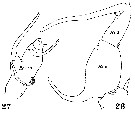 Issued from : W. Giesbrecht in Systematik und Faunistik der Pelagischen Copepoden des Golfes von Neapel und der angrenzenden Meeres-Abschnitte. – Fauna Flora Golf. Neapel, 1892, 19 , Atlas von 54 Tafeln. [Taf.17, Figs.27, 18]. Male: 27, exopod of left P5 (posterior view); 28, exopod of right P5 (anterior view).
|
 Issued from : W. Giesbrecht in Systematik und Faunistik der Pelagischen Copepoden des Golfes von Neapel und der angrenzenden Meeres-Abschnitte. - Fauna Flora Golf. Neapel, 1892, 19 , Atlas von 54 Tafeln. [Taf.38, Fig.1]. Male: 1, habitus (dorsal).
|
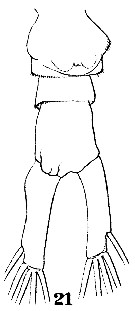 Issued from : W. Giesbrecht in Systematik und Faunistik der Pelagischen Copepoden des Golfes von Neapel und der angrenzenden Meeres-Abschnitte. - Fauna Flora Golf. Neapel, 1892, 19 , Atlas von 54 Tafeln. [Taf.38, Fig.21]. Female: 21, urosome (ventral).
|
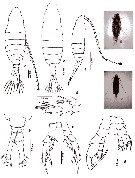 issued from : N. Phukham in Species diversity of calanoid copepods in Thai waters, Andaman Sea (Master of Science, Univ. Bangkok). 2008. [p.148, Fig.22]. Female (from W Malay Peninsula): a, habitus (dorsal); b, urosome; c, P5; d, detail of exopod 2 of P5. Male: e, habitus (dorsal); f, same (lateral); g, P5. Body length after the drawings: F = 1.925 mm; M = 1.933 mm.
| | | | | Compl. Ref.: | | | Sewell, 1932 (p.228); C.B. Wilson, 1950 (p.186); Krishnaswamy, 1953 (p.121); Chiba & al., 1957 a (p.11); Yamazi, 1958 (p.149, Rem.); Fagetti, 1962 (p.29); De Decker, 1964 (p.15, 20, 28); De Decker & Mombeck, 1964 (p.11); Fleminger, 1967 a (tabl.1); Timonin, 1971 (p.281, trophic group); Carter, 1977 (1978) (p.36); Madhu Pratap & al., 1977 (p.138, Table 3: abundance vs. stations); Stephen & Iyer, 1979 (p.228, tab.1, 3, 4, figs.3, 4); Sreekumaran Nair & al., 1981 (p.493); Madhupratap & al., 1981 (p.266, fig.1g: abundance vs. geographic transect); Kovalev & Shmeleva, 1982 (p.84); Dessier, 1983 (p.89, Tableau 1, Rem., %); De Decker, 1984 (p.316, 339: chart); Guangshan & Honglin, 1984 (p.118, tab.); Madhupratap & Haridas, 1986 (p.105, tab.1); Cervantes-Duarte & Hernandez-Trujillo, 1989 (tab.3: as C. calanus); Madhupratap & Haridas, 1990 (p.305, fig.4: vertical distribution night/day; fig.7: cluster); Yoo, 1991 (tab.1); Jiyalal Ram & Goswami, 1993 (p.129, tab.IV); Shih & Young, 1995 (p.69); Ohtsuka & al., 1996 b (p.153, Rem.: p.166, diet); Go & al., 1997 (tab.1, as calanininus); Padmavati & al., 1998 (p.349); Suarez-Morales & Gasca, 1998 a (p109); Noda & al., 1998 (p.55, Table 3, occurrence); Hsieh & Chiu, 1998 (tab.2); Wong & al, 1998 (tab.2); Madhupratap & al., 2001 (p. 1345, vertical distribution vs. O2, figs.4, 5: clusters, Rem.: p.1353); Hwang & al., 2003 (p.193, tab.2); Hsiao & al., 2004 (p.325, tab.1); Chang & Fang, 2004 (p.456, tab.1); Lan & al., 2004 (p.332, tab.1); Lo & al.*, 2004 (p.218, tab.1, fig.6); Lo & al., 2004 (p.89, tab.1); Zuo & al., 2006 (p.162: tab.1); Lopez-Ibarra & Palomares-Garcia, 2006 (p.63, Tabl. 1, seasonal abundance vs El-Niño); Rakhesh & al., 2006 (p.93, Table 2, spatial distribution); Hwang & al., 2006 (p.943, tab.I); Hwang & al., 2007 (p.24); Dur & al., 2007 (p.197, Table IV); Jitlang & al., 2008 (p.65, Table 1); Lan Y.C. & al., 2008 (p.61, Table 1, % vs stations); Morales-Ramirez & Suarez-Morales, 2008 (p.519); Tseng & al., 2008 (p.402, Table 2); Fernandes, 2008 (p.465, Tabl.2); Tseng L.-C. & al., 2008 (p.153, Table 2, occurrence vs geographic distribution); Tseng & al., 2009 (p.327, fig.5, feeding); Cornils & al., 2010 (p.2076, Table 3); W.-B. Chang & al., 2010 (p.735, Table 2, abundance); Shanthi & Ramanibai, 2011 (p.132, Table 1); Hsiao S.H. & al., 2011 (p.475, Appendix I); Hsiao & al., 2011 (p.317, Table 2, indicator of seasonal change); Tseng L.-C. & al., 2011 (p.47, Table 2, occurrences vs mesh sizes); in CalCOFI regional list (MDO, Nov. 2013; M. Ohman, comm. pers.; Tseng & al., 2013 (p.507, seasonal abundance); Tseng & al., 2013 a (p.1, Table 3, abundance); Jagadeesan & al., 2013 (p.27, Table 3, seasonal abundance); Anjusha & al., 2013 (p.40, Table 3, abundance & feeding behavior); Hwang & al., 2014 (p.43, Appendix A: seasonal abundance); Hirai & al., 2013 (p.1, Table I, molecular marker); Palomares-Garcia & al., 2018 (p.178, Table 1: occurrence not seen in La Paz) | | | | NZ: | 14 | | |
|
Distribution map of Centropages calaninus by geographical zones
|
| | | | | | | | | | | |  Issued from : M. Madhupratap & P. Haridas in J. Plankton Res., 12 (2). [p.311, Fig.4]. Issued from : M. Madhupratap & P. Haridas in J. Plankton Res., 12 (2). [p.311, Fig.4].
Vertical distribution of calanoid copepod (mean +1 SE), abundance No/100 m3. 28- Centropages calaninus.
Night: shaded, day: unshaded.
Samples collected from 6 stations located off Cochin (India), SE Arabian Sea, November 1983, with a Multiple Closing Plankton Net (mesh aperture 300 µm), in vertical hauls at 4 depth intervalls (0-200, 200-400, 400-600, 600-1000 m). |
| | | | Loc: | | | South Africa (E & W), SW Atlant., off Orenoque, W Mediterranean Sea, Bardawill Lagoon; Red Sea, Arabian Sea, Laccadive Is., Karavatti Is., Maldive Is., off Cochin, Sri Laznka, Natal, Madagascar, Rodrigues Is., Seychelles, Madras, E India, G. of Mannar, Palk Bay, Bay of Bengal, W Malay Peninsula (Andaman Sea), Indonesia-Malaysia, Banda Sea, Ambon Bay, Celebes Sea, Philippines, China Seas (Yellow Sea, East China Sea, South China Sea), Taiwan Strait, Taiwan (S, E, SW, Kaohsiung Harbor, NW, NE, N: Mienhua Canyon), Okinawa, S Korea, Japan, Kuchinoerabu Is., Aleutian Is., Bering Sea, Pacif. (equatorial, tropical), off Washington, California, W Baja California, Bahia Magdalena, W Pacif. (equatorial), Australia (Great Barrier, Moreton Bay), Fidji Is., Hawaii, W Costa Rica, off Panama, off Colombia, Galapagos, off Peru, off Chile | | | | N: | 96 (Atlant. S: 1; Medit.: 2; Red Sea: 1; Indian: 37; Indonesia-Malaysia: 7; Pacif.: 49) | | | | Lg.: | | | (26) F: 1,95-1,81; M: 1,86-1,68; (34) F: 1,92; (47) F: 2-1,9; M: 1,8; (101) F: 2,18-1,97; M: 2,06-1,8; (104) F: 1,9; (150) F: 1,97; M: 1,87; (290) F: 2-1,9; M: 2-1,85; (333) F: 1,72; (334) F: 1,9; M: 1,8; (530) F: 1,8; (776) F: 1,9; M: 1,7; (786) F: 2; M: 1,88-1,76; (795) F: 2; (866) M: 1,68-2,11; (1023) F: 1,82-2,04; M: 1,68-2,11; (1122) F: 1,9; M: 1,7; {F: 1,72-2,18; M: 1,68-2,11} | | | | Rem.: | epiplagic.
Timonin (1971, p.282) considers the trophic interrelations in the equatorial and tropical Indian Ocean, and divides the plankters into 6 trophic groups from the litterature and the results of studies of mouth-parts structure and intestine content. This species is omnivorous.
See in DVP Conway & al., 2003 (version 1) | | | Last update : 03/12/2020 | |
|
|
 Any use of this site for a publication will be mentioned with the following reference : Any use of this site for a publication will be mentioned with the following reference :
Razouls C., Desreumaux N., Kouwenberg J. and de Bovée F., 2005-2025. - Biodiversity of Marine Planktonic Copepods (morphology, geographical distribution and biological data). Sorbonne University, CNRS. Available at http://copepodes.obs-banyuls.fr/en [Accessed November 28, 2025] © copyright 2005-2025 Sorbonne University, CNRS
|
|
 |
 |

















